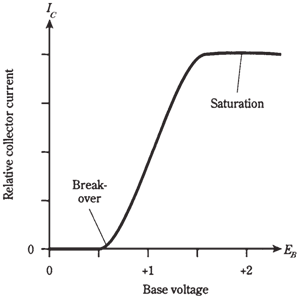Saturation:
If EB continues to increase, a point will eventually be reached when IC increases less rapidly. Ultimately, IC versus EB curve will level off. The transistor is then saturated. It is conducting as much as it possibly can; it is wide open.
This property of 3-layer semiconductors, in which the reverse-biased junctions can sometimes pass current, was 1st noticed in late forties by engineers Bardeen, Brattain, and Shockley at Bell Laboratories. When they saw how the current variations were magnified by the 3-layer device of this true, they knew they were on to some- thing. They envisioned that the effect could be exploited to amplify weak signals, or to use small currents to switch much larger ones. They should have been excited, but they surely had no idea how much their discovery would affect world.

Figure-- Relative collector current (IC) as a function of base voltage (EB) for a hypothetical silicon transistor.